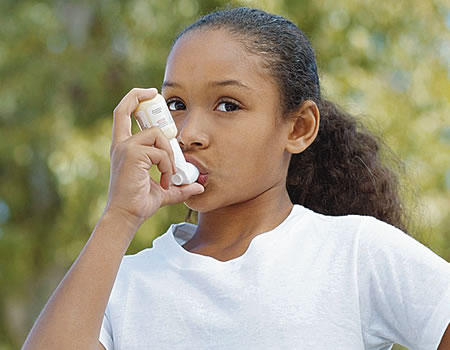It has also been discovered that living close to a busy road can expose children to pollutants from traffic that can increase the risk of asthma in childhood.
Air pollution is said to be more harmful to children since they have faster breathing rates and their lungs are still developing.
Asthma is a respiratory disease, with rising incidence the world over, even among children due to a combination of environmental and genetic factors. It most commonly develops in early childhood and more than three-quarters of children who developasthma symptoms before age seven no longer have symptoms by age 16. However, asthma can develop at any stage in life, including adulthood.
In a new study, researchers found that children living less than 100 meters from a busy road had nearly three times the odds of childhood asthma, compared to children who lived four times farther away from a busy road.
They suggested that asthma attacks in children, who live near a busy roadway, is often severe as they get more exposed to particles that are found in dust, soot, smoke, diesel and petrol fumes which enter into their lungs, making them inflamed and swollen.
What makes it worse is that symptoms of asthma, like wheezing sound when exhaling and chronic cough are common and can consequently lead to misdiagnosis.
The study, which appeared in the Journal of Allergy and Clinical Immunology, had analysed data from 1,522 Boston-area children born between 1999 and 2002 whose mothers had enrolled in a long-term study called Project Viva
The study was established to examine how behavioural and environmental factors, such as sleep and eating habits or exposure to pollution, impact children’s health.
The mothers provided comprehensive medical, socio-economic and demographic information, including residential address histories.
For the study, the researchers also linked home addresses to census data and satellite-derived atmospheric data to calculate each participant’s daily exposure to fine particulate matter (PM).
Particulate matter is tiny particles suspended in the air that when inhaled deposit in the terminal sacs of the lung. They originate from fuel combustion, including traffic, power plants and other pollution sources.
The research team also examined children’s daily exposure to soot or black carbon, a component of fine PM incompletely burned fossil fuels expelled from vehicular engines (especially diesel) and power plants produce black carbon, a known carcinogen.
Professor Soji Ige, a chest physician with the University College Hospital (UCH), Ibadan, Oyo State, said many things can trigger or make asthma more severe, including excessive exposure to soot from the exhaust of vehicles and when living close to a busy road.
He said exposure to poor quality air as a result of vehicular exhaust was also a reason for an increase in the risk of paediatric asthma, especially in early childhood and in urban areas.
“This impacts on their lung functions negatively. The particles, such as soot from the vehicular exhaust, are so small that they are likely to enter the lungs, making them inflamed and swollen. This can also trigger an asthma attack.
“Individuals already suffering from asthma, heart diseases, chronic bronchitis and even lung infections who live near busy roads are worst affected. Children and elderly at utmost risk suffer from exacerbations due to an increase in the pollutants in the surroundings,” he declared.
Professor Ige stated that the scenario is similar to that in dusty environment like Northern Nigeria where incidence of asthma is higher than in Southern Nigeria because of prolonged exposure to dust weather.
Previously, a study had listed common cold, household dust exposure and physical exercise topping the list of things that trigger asthma in children in Kano. Other asthma triggers include exposure to wood smoke and household sprays (insecticides). It was published in the journal, Tropical Journal of Medical Research.
Also, some children have been seen to have developed asthma after they have done strenuous exercises such as running, swimming or riding a bicycle. Conversely, environmental changes, like cold and thunderstorm, as well as certain food items and drugs, like aspirin, can also trigger or aggravate asthma.
The expert, however, said the increase in the prevalence of asthma in children is not unconnected with urbanisation and industrialisation.
He said: “The hygiene hypothesis explains manifestations of the disease. The lack of exposure to microbial organisms (microbes, or “germs”) in a child’s early years may be a contributing factor to the development of asthma and allergic diseases, particularly in developed countries.”
Repeated exposure to germs is thought to help the immune system learn to distinguish harmless foreign organisms from the harmful. Without it, the immune system does not develop the capacity to defend itself from microbes that cause or trigger diseases, such as asthma.
Professor Ige, however, declared that diet also plays a role in the development of asthma and other allergic diseases.
“Diets that are deficient in Vitamin B are causing trouble now, similarly those that are exposed to seafood, milk and milk products, cereals as well as nuts like groundnut can trigger attacks too in those that are genetically predisposed to asthma.
“Early onset asthma occurs in those that are predisposed. If the mother is asthmatic, there is about one-third probability of that offspring been asthmatic later in life. Also, if both parents are asthmatic, the risk of that individual being asthmatic becomes two thirds.
“So even if one is genetically predisposed and you prevent the environmental triggers, you can delay for a long time the development of asthma because the disease is both environmental and hereditary.”
The expert added that “some children also developasthma in childhood when fed artificial milk from the cow. Due to cow milk allergy, they can developasthma.
“That is why children should be exclusively breastfed to ensure they are not exposed to allergies early in life, thereby sensitised to developing asthma. There is a probability that their mother may also be asthmatic in nature.
“If you give them cow milk, you are exposing them to allergies very early in life and that is why we are saying that many of those allergic problems can be prevented by giving exclusive breast milk.”






